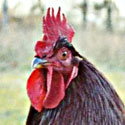
Frostbitten combs can be a problem for chickens that live in damp, drafty conditions during freezing weather. Toes may also be frostbitten, but not as commonly as combs and wattles, especially when the chickens have a place to rest where their feet are not in direct contact with a frozen surface.
The easiest way to prevent frostbitten combs and wattles is to opt for a breed with tight-fitting headgear, such as a cushion, rose, or walnut comb. The cushion-combed Chantecler, originating in Canada, was specifically developed to withstand bitter cold winters. The rose-combed Wyandotte is also well-suited to cold climates, as is the walnut-combed Yokohama.
Chickens sleeping on a properly constructed roost keep their feet warm by covering their feet with their feathered breasts. Installing some roosts close to the coop’s ceiling is beneficial, as the ceiling traps warmth from the chicken’s bodies.
Controlling humidity within the coop is an important frostbite prevention measure. During periods of cold weather, ambient humidity is usually low. Inside a coop, however, humidity can be high thanks to damp litter, fresh droppings, and respiration — especially when cold weather encourages chickens to spend more time than usual indoors. Humidity released by respiration can be controlled only through good ventilation. If the insides of your coop windows drip moisture, ventilation needs to be improved.
Keeping litter dry involves protecting open doors from blowing rain and snow, and keeping doorways cleared of snow so it won’t get tracked inside. Deep litter that’s stirred or topped off frequently will more readily absorb moisture from fresh droppings. Another option is to use a droppings board and frequently scrape off the fresh accumulation.
A coop will remain drier if the chickens are motivated to spend daylight hours outdoors. Encourage wintertime outdoor activities by providing a windbreak where your chickens can get out of icy winds and blowing snow. Establishing a covered outdoor area bedded with straw or shavings will give the chickens a place to loll away from snow or ice. But let the chickens decide for themselves if they’d rather be outdoors or in.
Making sure chickens remain hydrated is another important frostbite prevention measure. Hydration allows a chicken’s body to maintain good blood flow to combs and wattles to help keep these extremities warm. During winter weather, keep water from freezing by using a water fount base heater or encourage drinking by providing warm water at least three times a day. Wattles that get repeatedly dipped into the drinking water are more susceptible to freezing, a problem that can be minimized by installing either a small cup watering system or a nipple watering system.
The nighttime measure of coating combs and wattles with petroleum jelly (Vaseline) to prevent frostbite may work, depending on just how low the temperature goes and for how long. Such a coating works in three ways:
- It helps conserve heat that might otherwise dissipate from combs and wattles.
- It insulates the tissue from moisture and thus prevents freezing.
- It freezes at a slightly lower temperature than cell fluid in a comb or wattles and therefore protects these parts from freezing at temperatures hovering around the freezing point.
Note, however, that if the temperature dips much below the freezing point (32°F), especially for a prolonged period, petroleum jelly will freeze. When that happens, it becomes useless at preventing frostbite.
Where temperatures remain low for prolonged periods and the above measures are insufficient, you might use a flat-panel radiant heater attached to the ceiling to provide gentle heat during the night. Do not be tempted to heat the entire coop, however, which would be detrimental to flock health. And be sure to position the panel where your chickens can choose to roost under it, or not, as they prefer.
And that’s today’s news from the Cackle Coop.
Gail Damerow, author, The Chicken Health Handbook


This article mentions regulating humidity in the coop, but doesnt mention HOW MUCH humidity can cause frostbite? 60% 70% 80%?? That is the most important bit of info yet is not mentioned in this article.
We have not measured our humidity levels. But as stated above, if you see condensation on the windows or on a tin roof if you have one, there is probably too much humidity and you need to offer some ventilation. Another key indicator would be the smell of ammonia, which humidity would make much stronger.